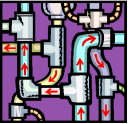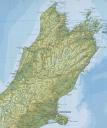Kathy and Bruce, an American expatriate couple here in New Zealand, invited several of us over to spend Christmas with them at their new place at Wainui out on the Banks Peninsula. They’ve got 10 acres in what has to be one of the most beautiful places in creation.
 For those of you who have little idea of where New Zealand is, much less the Banks Peninsula or Wainui, here’s a bit of help. If you look at the map of New Zealand, you will want to look on the South Island about half way down on the eastern coast.
For those of you who have little idea of where New Zealand is, much less the Banks Peninsula or Wainui, here’s a bit of help. If you look at the map of New Zealand, you will want to look on the South Island about half way down on the eastern coast.  The bit of land that pokes out there is the Banks Peninsula, which is an ancient volcanic cone. One of the walls of the cone has collapsed and the sea’s come in forming an inner harbor. If you look at the second map, which shows details of the Banks Peninsula, you can see the harbor and if you expand the map, you will find Wainui on the western shore of the harbor.
The bit of land that pokes out there is the Banks Peninsula, which is an ancient volcanic cone. One of the walls of the cone has collapsed and the sea’s come in forming an inner harbor. If you look at the second map, which shows details of the Banks Peninsula, you can see the harbor and if you expand the map, you will find Wainui on the western shore of the harbor.
 The day of the 24th began beautifully here in Christchurch and I drove out to Wainui on my motorcycle in the afternoon with the various food stuffs (I was responsible for the group’s salad makings) and beer required.
The day of the 24th began beautifully here in Christchurch and I drove out to Wainui on my motorcycle in the afternoon with the various food stuffs (I was responsible for the group’s salad makings) and beer required.  I stopped at Little River along the way for a cup of coffee and a sandwich called a “Butty”. It was bacon and egg between two slices of toasted bread and, one has to assume, some amount of butter. Whatever. it was good.
I stopped at Little River along the way for a cup of coffee and a sandwich called a “Butty”. It was bacon and egg between two slices of toasted bread and, one has to assume, some amount of butter. Whatever. it was good.
The ride to Wainui begins on the flat but about half way, you get into beautiful hills and you just never know what new sight will greet you around the next curve.  At one point, just after I passed a place called Hill Top, I had a great view of the Akaroa Harbor
At one point, just after I passed a place called Hill Top, I had a great view of the Akaroa Harbor  and then, a bit later, as I was approaching Wainui, I could see the gap further south where the sea broke into the inner cone long ago and out beyond that, the vast Pacific ocean stretching all the way to Antarctica.
and then, a bit later, as I was approaching Wainui, I could see the gap further south where the sea broke into the inner cone long ago and out beyond that, the vast Pacific ocean stretching all the way to Antarctica.
Kathy and Bruce’s place is on the side of the hills that rise above Wainui. and they are (according to my GPS) about 750 feet in elevation, or as they would say here, about 230 meters. And, for those of you who just have to know, (you are such geeks!) they would actually be located near:
S 43 48 270
E 172 52 881
 I took two photos of their place from a distance.
I took two photos of their place from a distance.  One is from the next road to the north of their road and the other is a telephoto shot from the other side of Akaroa Harbor a few days later when I was riding in that area. As you can see a lot of their 10 acres is forested or what folks here would call bush.
One is from the next road to the north of their road and the other is a telephoto shot from the other side of Akaroa Harbor a few days later when I was riding in that area. As you can see a lot of their 10 acres is forested or what folks here would call bush.
 When I arrived, Kathy and Bruce were there as were Mark and Ingrid (brother and sister travelers) and Alex and Tobi – two more American expatriates to New Zealand.
When I arrived, Kathy and Bruce were there as were Mark and Ingrid (brother and sister travelers) and Alex and Tobi – two more American expatriates to New Zealand.  I parked and threw my stuff into my room (had one of my very own!) and visited with everyone.
I parked and threw my stuff into my room (had one of my very own!) and visited with everyone.  The view from their place is spectacular and the former owners left it well laid out with lawns and beautiful flower beds full of plants, trees and flowers – most of which I had no idea how to identify. After awhile. I walked out and just went around the yard shooting pictures of all the strange and wonderful plants.
The view from their place is spectacular and the former owners left it well laid out with lawns and beautiful flower beds full of plants, trees and flowers – most of which I had no idea how to identify. After awhile. I walked out and just went around the yard shooting pictures of all the strange and wonderful plants.









 Wow-ee-Zowie, batman – that’s a lot of cool plants. Here are some shots of their house from the outside. The place has a concrete block in the back yard that says, I believe, 1898, or something around there as when this place was settled. I regret that I didn’t shoot more pictures of the outside of the house. It has a big Australian style porch on one side and one morning when it was pouring rain, I went out there and sat safe and dry and watched the wind tossing the trees, the clouds moving above and the rain driving. Glorious.
Wow-ee-Zowie, batman – that’s a lot of cool plants. Here are some shots of their house from the outside. The place has a concrete block in the back yard that says, I believe, 1898, or something around there as when this place was settled. I regret that I didn’t shoot more pictures of the outside of the house. It has a big Australian style porch on one side and one morning when it was pouring rain, I went out there and sat safe and dry and watched the wind tossing the trees, the clouds moving above and the rain driving. Glorious.


 In the house, food preparations were under way. I think most of the folks there could gracefully bear the title of ‘ Organic Food-ees’ which translates to ‘We like to prepare and enjoy food and we think it is ever so much better, and better for us, if it is all organic‘.
In the house, food preparations were under way. I think most of the folks there could gracefully bear the title of ‘ Organic Food-ees’ which translates to ‘We like to prepare and enjoy food and we think it is ever so much better, and better for us, if it is all organic‘.  I had brought the makings for two day’s worth of salads and it was all organic having been bought at an all organic food market a day previous. Other folks had collected everything necessary to make organic pizzas and wonderful French Toasts and on and on.
I had brought the makings for two day’s worth of salads and it was all organic having been bought at an all organic food market a day previous. Other folks had collected everything necessary to make organic pizzas and wonderful French Toasts and on and on.  I could see when I arrived that it was going to be a great few days. There was a nice feeling in the house and everyone was having fun. Oh, and since I like food a lot, I thought things were looking promising indeed.
I could see when I arrived that it was going to be a great few days. There was a nice feeling in the house and everyone was having fun. Oh, and since I like food a lot, I thought things were looking promising indeed.
My friends, who know that I am anything but a cook, might be surprised to know I spent a fair amount of time in and around the kitchen.  But, having very limited skills, I did a lot of dish washing and kibitzing and helped prepare the salads. Ah yes, and a few beers did get consumed along the way there too.
But, having very limited skills, I did a lot of dish washing and kibitzing and helped prepare the salads. Ah yes, and a few beers did get consumed along the way there too.
Much of the three day holiday there centered around the kitchen. It seemed like one meal would be finished and the clean up completed and before long, folks would be bustling about and working on the next culinary adventure.  If we’d been eating normal ‘heavy’ food, this would have been far too much but given that everything we were eating was fairly light and definitely healthy, it was just right – and a lot of fun.
If we’d been eating normal ‘heavy’ food, this would have been far too much but given that everything we were eating was fairly light and definitely healthy, it was just right – and a lot of fun.
Now, I don’t mean to suggest that nothing else got done. There were many great discussions held along the way.  And, Kathy and Bruce also taught us to play a great table game with interesting and complex rules quite unlike anything I’d ever played before. It was more subtle than it looked. I’m pretty sure I understood the rules and the play action
And, Kathy and Bruce also taught us to play a great table game with interesting and complex rules quite unlike anything I’d ever played before. It was more subtle than it looked. I’m pretty sure I understood the rules and the play action  but I’d have to say that most of the strategy may have escaped me since I seemed to have come in last or very near each time we played. It was a hard game for a Leo – but I tried to bear up <smile>.
but I’d have to say that most of the strategy may have escaped me since I seemed to have come in last or very near each time we played. It was a hard game for a Leo – but I tried to bear up <smile>.
On the 25th, Mark and his sister, Ingrid, departed in their van headed for Golden Bay up at the north end of the island. We all wondered how far they’d get as we all doubted they’d find any gas stations open on Christmas day.  But, they said they had a lot of gas and took off after goodbyes all around, quite undaunted. Very nice people. We heard later that they’d done just fine.
But, they said they had a lot of gas and took off after goodbyes all around, quite undaunted. Very nice people. We heard later that they’d done just fine.
So, there were less of us for the balance of Christmas day. Just Bruce and Kathy, Alex and Tobi and myself. And, of course, Alex and Tobi’s two little dogs; Jules and Ella.

They’d also brought their very cool and vocal cat, Seibu, but he was staying up in their quarters – which was a separate residence on the same property just uphill from the main house.
Each night, some of us seemed to stay up later and later talking. On Christmas night, Bruce and I talked to after 1 AM. On the following evening, we were up yammering away until past 2 AM. Great conversations both evenings. Alex and Tobi generally turn in fairly early. Kathy tried to stay with us but each evening she faded an hour or two earlier that Bruce and I.
On the 26th, Maggie and her husband, Roelf, who are both South African immigrants to New Zealand arrived for the day. Needless to say <smile>, the only possible response to this incursion was – more food preparation! So, more pizzas were cooked and salads made and we feasted yet once again. And then the table game began again with Roelf now as ‘the new blood’. But, he was much better at it than I was in spite of my head-start and so I cleaned up at the rear of the pack again.
I discovered that Roelf and I shared an interest in isolated and remote islands and once we began talking, it was evident that he’d had a lot of interesting experiences along this line. After he graduated from University, he’d applied for and been accepted into South Africa’s National Antarctic Programme and went down and spent a year at South Africa’s Antarctic base, SANAE IV ➡. Later, he also spent a year on Marion Island ➡ and also some time on Gough Island ➡ as well. I found all of this extremely interesting.
On Christmas Day, after Mark and Ingrid had gone and during the preparation of the next meal, the house’s water ran out. The spigots just blew air when you opened them. Bruce went out to have a look and I joined him a bit later.
 The water for their place comes from a spring that’s up the hill from their main house. From the spring, it flows downhill by gravity and into a large above-ground plastic water tank. I’d guess this must hold 5000 gallons or so when full. Bruce thought that the flow from the spring had stopped and was investigating that possibility when I looked into the water tank and saw that it was half full.
The water for their place comes from a spring that’s up the hill from their main house. From the spring, it flows downhill by gravity and into a large above-ground plastic water tank. I’d guess this must hold 5000 gallons or so when full. Bruce thought that the flow from the spring had stopped and was investigating that possibility when I looked into the water tank and saw that it was half full.  At that point, I suggested that with that much water ready to go, we should look for the problem between the tank and the house. He agreed.
At that point, I suggested that with that much water ready to go, we should look for the problem between the tank and the house. He agreed.
The first thing we did, after a brief look at the pump and air-bladder tank at the house, was to unhook the hoses from the tank’s output side and open the valve to see if we had flow at that point. We did not. I thought then that there must be something in the tank plugging the outflow. But, when we opened the lid and again and looked closer, we could see that the outflow pipe actually came half way up to the top of the tank and therefore the tank would only deliver water until its level had dropped to the half-way point. This meant that Bruce had been ight in the first place to suspect the circuit between the spring and the tank.
While I was reconnecting pipes on the outflow side, he began to investigate the pipes on the inflow side and in just a moment or two I heard the sweet sound of water running into the tank from the spring. He’d opened and closed an overflow valve and somehow that had cleared the problem and all was well again and a lot more was known about how the water system there worked.  And that’s a good thing because water is definitely important.
And that’s a good thing because water is definitely important.
We returned to the house while the women ran in front of us scattering flowers at out feet and praising our vast plumbing skills … what? No one else remembers that? Ah, perhaps I just imagined that part, eh?
But, the truth is no one was unhappy that the water was back on <smile>.
Here’s a block of additional photos I shot inside the house. Run your mouse over each photo to see a brief explanation and click on any photos to see a bigger version of it.






Originally, I had intended to stay until the afternoon of the 26th but we were having so much fun, and Kathy and Bruce didn’t mind, so I stayed on until the morning of the 27th.  I’m glad I did or I’d have missed the long talk Bruce and I had until after 2 AM that night. We covered religion, philosophy and the world’s situation. It was a great ramble.
I’m glad I did or I’d have missed the long talk Bruce and I had until after 2 AM that night. We covered religion, philosophy and the world’s situation. It was a great ramble.
Finally, about mid-day on the 27th, I packed up and left. Maggie and Roelf had been nice enough to carry my juicer home in their car and all the food I’d brought had been consumed so I was actually traveling light which is always nice on a motorcycle.
I headed south from Bruce and Kathy’s down along the western shore of Akaroa Harbor towards the gap where the Pacific Ocean comes in.  The small paved road wound along near the water for awhile and then it began to climb until it was nearly 2000 feet up. All along were beautiful views of the peninsula and the harbor.
The small paved road wound along near the water for awhile and then it began to climb until it was nearly 2000 feet up. All along were beautiful views of the peninsula and the harbor.  Finally, the road changed to gravel and continued. Cattle behind the fences on either side inspected me as I passed. They had no idea how beautiful their grazing fields were. I continued on over the gravel though it is a bit dicey on a heavy motorcycle with street tires and a lot of power. The tires squirm from side to side as they push the gravel aside and using the brakes is something one has to do with caution.
Finally, the road changed to gravel and continued. Cattle behind the fences on either side inspected me as I passed. They had no idea how beautiful their grazing fields were. I continued on over the gravel though it is a bit dicey on a heavy motorcycle with street tires and a lot of power. The tires squirm from side to side as they push the gravel aside and using the brakes is something one has to do with caution.  Finally, the road took a steep decent and several sharp switchbacks and I decided to turn around. I could just see myself going into a slide on the sharp slope and then off the end of a switchback – yuk!
Finally, the road took a steep decent and several sharp switchbacks and I decided to turn around. I could just see myself going into a slide on the sharp slope and then off the end of a switchback – yuk!
I back-tracked by Bruce and Kathy’s and shot the photo (posted above) of their place from Cemetery Road (the road across the Wainui Valley from theirs). Then I continued on and swung around the northern end of the harbor, bought some gas at Duvauchelle and then continued towards Akaroa where a road called the Summit Road begins.
The Summit Road climbs to and then follows the highest backbone of the Banks Peninsula so the views from it are awesome.  From up there, I could look across the harbor to Wainui and I took a telephoto shot of Bruce and Kathy’s valley (also posted above).
From up there, I could look across the harbor to Wainui and I took a telephoto shot of Bruce and Kathy’s valley (also posted above).
Soon, I came to a side road to Le Bon Bay and I took it. This took me due west sown a long and beautiful verdant green valley to finally to a bay at the end of the valley. There were a few homes along the road and a collection of about 10 baches (New Zealand lingo for a small vacation home or shack) at the end of the road by the bay. No stores, no services. Just one very beautiful place at the end of the earth.
There were two or three tractors out on the sand. They often use tractors to back the boats and their trailers into the surf where the boats are floated off and then the tractor pulls the empty trailer back up onto the beach until it is needed. I’m not sure, but I think some of the tractor owners make spare money by performing this service for the boaties.
I stood out on the beach and put my camera into movie mode and then did a long slow turn-around panorama of the bay. I’m glad I did it because I still have the video clip but doing this somehow confused my camera and after that, it wouldn’t shoot any more pictures; still or moving. That was a bit of a bummer.
About the same time, I noticed that the beautiful skies were beginning to cloud over and the air was getting cooler. Mmmmm. Could be time to move on.

I rode back up out of the valley, which again was an ascent from sea level to over 2000 feet, and continued north on the Summit Road. I passed several more interesting side roads down to places like Okains Bay and Little Akaloa Bay but I’d decided to save them for my next foray. it was getting cold and I was wondering if my camera could be recovered or not so I decided to push back to Little River, get a bite to eat and a Latte and then blaze for home.
– – – – – – – – – – – – –
Postscript: Kathy and Bruce have posted their photos of Christmas at Wainui as well and they are excellent. They can be found here: ➡ Once you get to the photos, just click ‘View Photos’. You do not have to join the site to see them.











